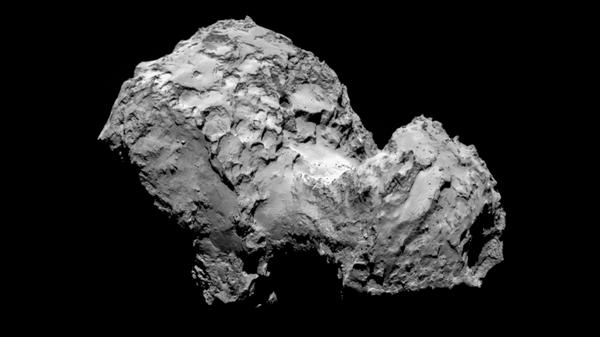
Comet 67P/Churyumov–Gerasimenko as seen from the European Space Agency's Rosetta spacecraft
Credit: European Space Agency/Twitter
As Douglas Adams wisely wrote, "... you may think it's a long way down the road to the chemist's, but that's just peanuts to space ..."1
Case in point: the European Space Agency's Rosetta spacecraft. After 10 years & 3.7 billion miles (6 billion kilometres), it has finally caught up to comet 67P/Churyumov-Gerasimenk. Rosetta is now in orbit around the comet, & the pair continue to orbit the Sun at 34,000 miles per hour (54,700 kph, 9.4 miles per second, 15.2 km per second).
Further study will include an attempted landing on the surface of the asteroid in November, by a robotic probe named Philae. If you are thinking that part will be easy, think again. There are still many unknowns. One member of the European Space Agency's team recently pointed out that the hardness of the asteroid is, "... somewhere between cement & candyfloss."
http://news.discovery.com/space/asteroids-meteors-meteorites/rosetta-probe-makes-historic-comet-rendezvous-140806.htm
http://www.economist.com/news/science-and-technology/21611028-european-space-probe-has-just-arrived-its-destination-rosettas-stone
__________
1 Douglas Adams: “The Hitchhikers Guide to the Galaxy”, Chapter 8, 1979
/ space probe Rosetta historic rendezvous comet 10 year 3.7 billion mile chase Solar System European Space Agency ESA comet Rosetta's flight operations manager Sylvain Lodiot mission control Darmstadt Germany spacecraft orbit around a comet wanderer Solar System primeval dust ice may how the planets formed comet encounters November robotic robot scientific lab laboratory Philae surface first ever landing comet Rosetta's rendezvous Comet 67P/Churyumov-Gerasimenko 400 million km from Earth signals received ground stations ESA Director General Jean-Jacques Dordain design build launch three-tonne craft tiny target deep space unique mission scientific goal origins understand our future Rosetta mission world science space community Jean-Yves Le Gall president France's National Centre for Space Research (CNES), a major contributor to the project two lobes joined by a neck pucked impact marks first clear views comet project scientist Matt Taylor double lobed structure built from two separate comets that came together in the Solar System's history, or is it one comet that has eroded dramatically asymmetrically launched March 2004 four flybys Mars Earth gravitational force slingshot build up speed catch up 31-month hibernation light from the distant Sun solar panels wake-up call from Earth complex series maneuvers slow down walking speed relative to the comet /
No comments:
Post a Comment